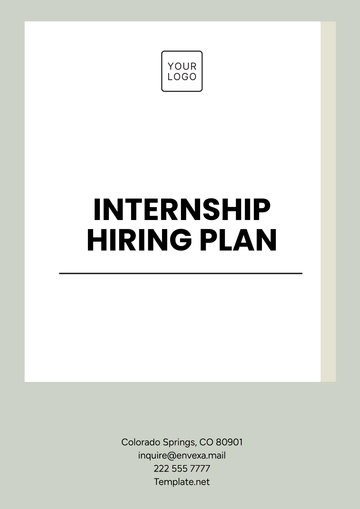Free Remote Hiring Plan Format

Introduction
This section provides an overview of the remote hiring plan, detailing the objectives, processes, and goals of the recruitment strategy. It outlines how remote roles will be filled, the benefits of hiring remotely, and the alignment of the plan with organizational needs and growth.
1. Hiring Objectives and Goals
This section should clearly outline the main objectives of the hiring plan, including:
Goal 1: Expanding the talent pool by hiring globally.
Goal 2: Streamlining recruitment to ensure efficiency.
Goal 3: Building diverse and inclusive teams with a focus on remote work compatibility.
Goal 4: Enhancing employee retention through the implementation of flexible work arrangements.
2. Job Role Definitions
Provide a clear description of the remote positions to be filled. Each role should include:
Job Title: Specify the role’s name.
Job Description: Outline the responsibilities, expectations, and tasks associated with the role.
Skills and Experience: List the required qualifications, technical skills, and professional experience.
Compensation Package: Define the salary range, benefits, and other compensation details.
3. Recruitment Process
Outline the process for sourcing and hiring remote employees. This should include the following stages:
3.1. Sourcing Candidates
Job Boards & Platforms: Identify where job openings will be posted (e.g., LinkedIn, Indeed, Remote OK, etc.).
Social Media: Utilize platforms like Twitter, Facebook, and specialized remote work groups.
Employee Referrals: Encourage employees to refer candidates.
3.2. Screening and Selection
Resume Review: Criteria for reviewing resumes and cover letters.
Initial Interview: Virtual interview conducted via video conferencing tools (Zoom, Teams, etc.).
Skill Assessment: Include tests or challenges that simulate remote work scenarios.
Cultural Fit: Evaluate the candidate’s alignment with the organization’s remote work culture and values.
3.3. Interview Process
Video Interviews: Structured and unstructured video interviews with key team members.
Multiple Rounds: Depending on the role, conduct additional rounds focusing on technical skills, problem-solving, or team compatibility.
Final Evaluation: Involve the leadership or management team in the final hiring decision.
4. Onboarding Process
A seamless onboarding process is crucial for remote hires. This section should outline the steps to integrate new employees into the company, ensuring they have the tools and knowledge to succeed remotely.
4.1. Pre-Boarding Activities
Introduction Email: Send an introductory email outlining the onboarding process.
Documentation: Share important documents (e.g., contracts, company policies, etc.) electronically.
4.2. First Week Activities
Orientation Session: Virtual meetings to familiarize the new hire with company culture, tools, and resources.
Team Introductions: Arrange virtual introductions with team members and direct managers.
Tools Setup: Ensure the employee has all necessary tools (laptop, software, communication platforms) set up.
4.3. Ongoing Support
Regular Check-ins: Schedule weekly or bi-weekly meetings with HR or direct managers to ensure smooth integration.
Training Programs: Provide access to online courses or in-house training to build required skills.
Mentorship: Assign a mentor to support the new hire through the initial phase of their remote work.
5. Communication and Collaboration Tools
Detail the tools and platforms that will be used to facilitate remote communication and collaboration, such as:
Video Conferencing: Zoom, Google Meet, Microsoft Teams
Project Management: Asana, Trello, Monday.com
Instant Messaging: Slack, Microsoft Teams, Discord
File Sharing: Google Drive, Dropbox, OneDrive
6. Performance and Evaluation
This section defines how the performance of remote employees will be measured, ensuring continuous improvement and effective work:
KPIs: Establish clear key performance indicators that align with remote work goals.
Feedback Mechanisms: Implement regular feedback loops through performance reviews, one-on-one meetings, and peer reviews.
Work-Life Balance: Address the importance of maintaining a healthy work-life balance and monitor employee well-being.
7. Legal and Compliance Considerations
Remote hiring comes with legal considerations that need to be addressed:
Employment Laws: Ensure compliance with the local labor laws of the employee’s location.
Tax Implications: Understand the tax rules in the employee’s jurisdiction for payroll and benefits.
Data Security: Follow best practices to maintain the security of company data and protect remote employees' privacy.
8. Conclusion
Summarize the key points of the remote hiring plan, emphasizing the goals, methods, and tools that will ensure successful recruitment and integration of remote employees.
Contact Information
Include a section for contact details, including HR personnel or recruitment specialists who can answer any questions or concerns.
Name: [YOUR NAME]
Email: [YOUR COMPANY EMAIL]
Phone: [YOUR COMPANY NUMBER]
- 100% Customizable, free editor
- Access 1 Million+ Templates, photo’s & graphics
- Download or share as a template
- Click and replace photos, graphics, text, backgrounds
- Resize, crop, AI write & more
- Access advanced editor
The Remote Hiring Plan Format Template from Template.net is an editable and customizable tool designed for remote workforce recruitment. Easily adapt the template to suit your company’s specific needs. Fully editable in our AI Editor Tool, this flexible template streamlines your hiring process, ensuring a seamless and efficient approach to recruiting remote talent.
You may also like
- Finance Plan
- Construction Plan
- Sales Plan
- Development Plan
- Career Plan
- Budget Plan
- HR Plan
- Education Plan
- Transition Plan
- Work Plan
- Training Plan
- Communication Plan
- Operation Plan
- Health And Safety Plan
- Strategy Plan
- Professional Development Plan
- Advertising Plan
- Risk Management Plan
- Restaurant Plan
- School Plan
- Nursing Home Patient Care Plan
- Nursing Care Plan
- Plan Event
- Startup Plan
- Social Media Plan
- Staffing Plan
- Annual Plan
- Content Plan
- Payment Plan
- Implementation Plan
- Hotel Plan
- Workout Plan
- Accounting Plan
- Campaign Plan
- Essay Plan
- 30 60 90 Day Plan
- Research Plan
- Recruitment Plan
- 90 Day Plan
- Quarterly Plan
- Emergency Plan
- 5 Year Plan
- Gym Plan
- Personal Plan
- IT and Software Plan
- Treatment Plan
- Real Estate Plan
- Law Firm Plan
- Healthcare Plan
- Improvement Plan
- Media Plan
- 5 Year Business Plan
- Learning Plan
- Marketing Campaign Plan
- Travel Agency Plan
- Cleaning Services Plan
- Interior Design Plan
- Performance Plan
- PR Plan
- Birth Plan
- Life Plan
- SEO Plan
- Disaster Recovery Plan
- Continuity Plan
- Launch Plan
- Legal Plan
- Behavior Plan
- Performance Improvement Plan
- Salon Plan
- Security Plan
- Security Management Plan
- Employee Development Plan
- Quality Plan
- Service Improvement Plan
- Growth Plan
- Incident Response Plan
- Basketball Plan
- Emergency Action Plan
- Product Launch Plan
- Spa Plan
- Employee Training Plan
- Data Analysis Plan
- Employee Action Plan
- Territory Plan
- Audit Plan
- Classroom Plan
- Activity Plan
- Parenting Plan
- Care Plan
- Project Execution Plan
- Exercise Plan
- Internship Plan
- Software Development Plan
- Continuous Improvement Plan
- Leave Plan
- 90 Day Sales Plan
- Advertising Agency Plan
- Employee Transition Plan
- Smart Action Plan
- Workplace Safety Plan
- Behavior Change Plan
- Contingency Plan
- Continuity of Operations Plan
- Health Plan
- Quality Control Plan
- Self Plan
- Sports Development Plan
- Change Management Plan
- Ecommerce Plan
- Personal Financial Plan
- Process Improvement Plan
- 30-60-90 Day Sales Plan
- Crisis Management Plan
- Engagement Plan
- Execution Plan
- Pandemic Plan
- Quality Assurance Plan
- Service Continuity Plan
- Agile Project Plan
- Fundraising Plan
- Job Transition Plan
- Asset Maintenance Plan
- Maintenance Plan
- Software Test Plan
- Staff Training and Development Plan
- 3 Year Plan
- Brand Activation Plan
- Release Plan
- Resource Plan
- Risk Mitigation Plan
- Teacher Plan
- 30 60 90 Day Plan for New Manager
- Food Safety Plan
- Food Truck Plan
- Hiring Plan
- Quality Management Plan
- Wellness Plan
- Behavior Intervention Plan
- Bonus Plan
- Investment Plan
- Maternity Leave Plan
- Pandemic Response Plan
- Succession Planning
- Coaching Plan
- Configuration Management Plan
- Remote Work Plan
- Self Care Plan
- Teaching Plan
- 100-Day Plan
- HACCP Plan
- Student Plan
- Sustainability Plan
- 30 60 90 Day Plan for Interview
- Access Plan
- Site Specific Safety Plan
























